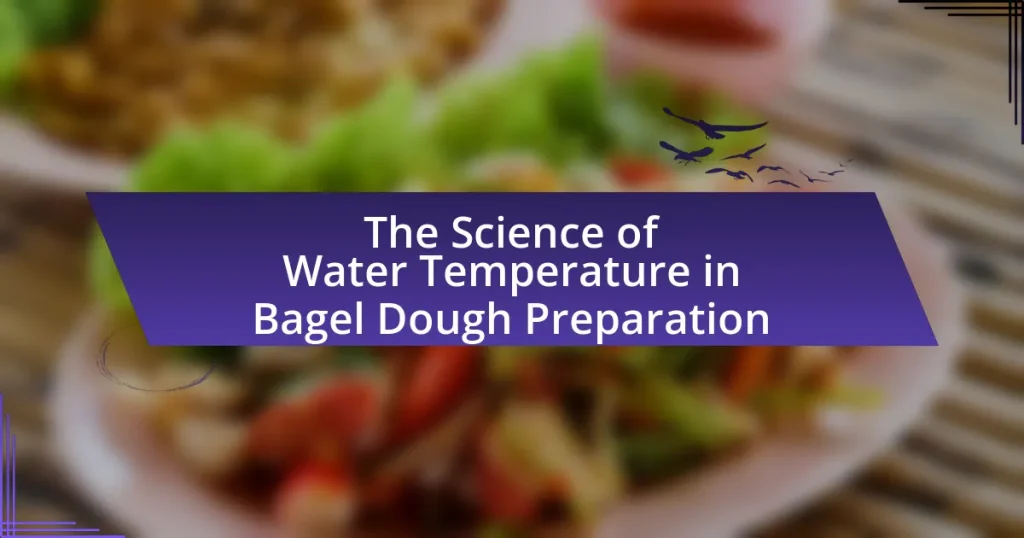The article focuses on the essential techniques and ingredients required to achieve the ideal crust for bagels. Key elements include the use of high-gluten flour, proper fermentation, boiling before baking, and high-temperature baking, all of which contribute to the bagel’s texture and flavor. It discusses how dough composition, hydration levels, and fermentation methods impact crust quality, as well as the significance of boiling and baking techniques. Additionally, the article highlights common mistakes to avoid and offers expert tips for perfecting bagel crust at home, ensuring a consistent and desirable outcome.

What are the key elements of achieving the ideal crust for bagels?
The key elements of achieving the ideal crust for bagels include the use of high-gluten flour, proper fermentation, boiling before baking, and baking at high temperatures. High-gluten flour contributes to the chewy texture and structure of the bagel, while proper fermentation allows for flavor development and dough strength. Boiling the bagels in water, often with added malt or baking soda, creates a shiny, firm crust by gelatinizing the starches on the surface. Finally, baking at high temperatures, typically around 450°F to 500°F, ensures a crisp exterior while maintaining a soft interior. These methods are supported by traditional bagel-making practices and culinary science, which emphasize the importance of each step in achieving the desired crust quality.
How does the dough composition affect the crust quality?
Dough composition significantly influences crust quality by determining texture, color, and flavor. The balance of ingredients such as flour type, water content, yeast, and sugar affects gluten development, which in turn impacts the crust’s structure and crispness. For instance, high-protein flours create stronger gluten networks, resulting in a chewier crust, while lower-protein flours yield a softer texture. Additionally, the hydration level of the dough influences steam production during baking, contributing to crust thickness and browning. Research indicates that doughs with higher sugar content caramelize better, enhancing flavor and color in the crust. Thus, the specific ratios and types of ingredients in the dough are crucial for achieving the desired crust quality in bagels.
What ingredients are essential for a perfect bagel crust?
The essential ingredients for a perfect bagel crust are high-gluten flour, water, salt, and malt syrup. High-gluten flour provides the necessary protein content for a chewy texture, while water hydrates the flour to form gluten. Salt enhances flavor and strengthens the dough, and malt syrup contributes to browning and adds a slight sweetness. These ingredients work together to create the distinctive crust that characterizes a well-made bagel.
How does hydration level influence the crust texture?
Hydration level significantly influences crust texture by affecting the dough’s elasticity and moisture content. Higher hydration levels lead to a softer, more open crumb structure and a thinner, crisper crust due to increased steam production during baking. Conversely, lower hydration results in a denser crumb and a thicker, chewier crust. Research indicates that doughs with hydration levels above 70% produce a more desirable crust texture, as the steam generated helps create a better oven spring and enhances browning through the Maillard reaction.
What role does fermentation play in crust development?
Fermentation is crucial in crust development as it enhances flavor, texture, and color. During fermentation, yeast produces carbon dioxide, which creates air pockets in the dough, leading to a lighter and chewier crust. Additionally, the byproducts of fermentation, such as organic acids, contribute to the Maillard reaction during baking, resulting in a desirable golden-brown crust. Studies show that longer fermentation times improve the overall quality of the crust, making it more appealing and flavorful.
How does the fermentation time impact flavor and texture?
Fermentation time significantly impacts the flavor and texture of bagels. Longer fermentation allows for more complex flavor development due to the breakdown of sugars and proteins by yeast and bacteria, resulting in a richer taste profile. Additionally, extended fermentation enhances the texture by promoting gluten development, leading to a chewier and denser bagel. Research indicates that a fermentation period of 12 to 24 hours can yield optimal flavor and texture, as observed in studies on artisan bread-making techniques, which emphasize the importance of time in fermentation for achieving desired sensory qualities.
What types of fermentation methods can be used for bagels?
The types of fermentation methods that can be used for bagels include straight dough fermentation, sponge fermentation, and cold fermentation. Straight dough fermentation involves mixing all ingredients at once and allowing the dough to rise, typically resulting in a quicker process. Sponge fermentation, on the other hand, requires creating a pre-ferment (sponge) that ferments before being mixed with the remaining ingredients, enhancing flavor and texture. Cold fermentation involves refrigerating the dough for an extended period, which develops a more complex flavor profile due to the slower fermentation process. Each method contributes uniquely to the bagel’s final taste and texture, with cold fermentation often preferred for its depth of flavor.

What baking methods contribute to a perfect bagel crust?
Boiling the bagels before baking is the primary method that contributes to a perfect bagel crust. This technique gelatinizes the starches on the surface, creating a chewy texture and a shiny finish. Additionally, baking at a high temperature, typically around 450°F (232°C), allows for rapid crust formation, enhancing the overall texture and flavor. The use of steam in the oven during the initial baking phase also helps achieve a crispier crust by keeping the outer layer moist, which promotes better browning. These methods are essential for producing the characteristic crust that distinguishes bagels from other baked goods.
How does boiling affect the crust of bagels?
Boiling bagels before baking significantly enhances their crust by creating a chewy texture and a glossy finish. The boiling process gelatinizes the starches on the surface of the dough, which helps form a barrier that retains moisture during baking. This results in a denser, more flavorful crust. Additionally, boiling in water that contains malt or baking soda can further contribute to browning and flavor development due to the Maillard reaction, which occurs during the baking process.
What is the ideal boiling time for achieving the best crust?
The ideal boiling time for achieving the best crust on bagels is 30 to 60 seconds per side. This brief boiling period allows the outer layer of the bagel to gelatinize, creating a chewy texture and a shiny crust. Research indicates that boiling bagels for this duration enhances their overall structure and flavor, as it helps to set the crust before baking, resulting in a desirable balance of chewiness and crispness.
What ingredients can be added to the boiling water for enhanced flavor?
Salt is the primary ingredient that can be added to boiling water for enhanced flavor when making bagels. Adding approximately 1 to 2 tablespoons of salt per gallon of water not only enhances the taste of the bagels but also helps to create a firmer crust. Additionally, malt syrup or barley malt can be included to impart a subtle sweetness and improve the color of the crust. These ingredients are commonly used in traditional bagel recipes to achieve the desired flavor and texture, reinforcing their importance in the boiling process.
What are the different baking techniques for bagels?
The different baking techniques for bagels include boiling, baking, and steaming. Boiling bagels in a mixture of water and malt syrup before baking creates a chewy texture and shiny crust, which is a traditional method used in New York-style bagels. Baking them directly in the oven without boiling results in a denser texture and less shine, while steaming bagels during the baking process can enhance moisture and create a softer crust. Each technique affects the final product’s texture and flavor, with boiling being the most widely recognized method for achieving the classic bagel characteristics.
How does baking temperature influence crust formation?
Baking temperature significantly influences crust formation by determining the Maillard reaction and caramelization processes, which contribute to flavor and color. Higher temperatures, typically between 425°F to 475°F, promote rapid moisture evaporation and create a crispy outer layer while allowing the interior to remain soft and chewy. Research indicates that at these elevated temperatures, the Maillard reaction occurs more efficiently, enhancing the browning and flavor complexity of the crust. Conversely, lower temperatures result in a softer, less developed crust due to slower moisture loss and insufficient browning reactions.
What types of ovens are best for baking bagels?
The best types of ovens for baking bagels are steam ovens and deck ovens. Steam ovens provide moisture during the baking process, which helps achieve a chewy crust, while deck ovens offer even heat distribution and high temperatures, essential for creating the ideal bagel texture. Research indicates that the combination of steam and high heat is crucial for developing the characteristic crust and interior of a bagel, as evidenced by traditional bagel baking methods used in New York City, where these oven types are commonly employed.

What common mistakes should be avoided when baking bagels?
Common mistakes to avoid when baking bagels include not boiling the bagels before baking, using insufficient flour, and neglecting proper fermentation. Boiling bagels is essential as it creates the characteristic chewy texture and shiny crust; skipping this step results in a dense product. Additionally, using too little flour can lead to a sticky dough that is difficult to shape, while inadequate fermentation can prevent the development of flavor and texture. These practices are supported by baking science, which emphasizes the importance of boiling and proper dough handling in achieving the ideal bagel.
How can over-proofing affect the bagel crust?
Over-proofing can lead to a bagel crust that is overly soft and lacks the desired chewiness. When bagels are left to proof for too long, the gluten structure weakens, resulting in a crust that does not develop properly during baking. This is because the excessive fermentation causes the dough to become too airy, preventing the formation of a robust outer layer. As a result, the bagel may not achieve the characteristic golden-brown color and crispy texture that is typically associated with well-made bagels.
What signs indicate that bagels are over-proofed?
Signs that indicate bagels are over-proofed include excessive puffiness and a very soft texture. When bagels are over-proofed, they may also exhibit a loss of shape, appearing overly bloated and lacking the characteristic density. Additionally, if the bagels collapse or deflate when handled, this is a clear sign of over-proofing. These characteristics arise because the yeast has consumed too much sugar, leading to an imbalance in the dough structure.
How can one prevent over-proofing during the process?
To prevent over-proofing during the bagel-making process, one should monitor the dough closely and perform the “poke test.” This test involves gently poking the dough; if it springs back slowly, it is ready, but if it springs back quickly, it needs more time to proof. Additionally, controlling the fermentation temperature is crucial; cooler temperatures slow down yeast activity, reducing the risk of over-proofing. Research indicates that maintaining a temperature around 75°F to 80°F is optimal for yeast activity without leading to over-proofing.
What are the best practices for achieving a consistent crust?
To achieve a consistent crust on bagels, it is essential to follow specific practices such as using a high-gluten flour, maintaining proper hydration levels, and employing a boiling step before baking. High-gluten flour contributes to the chewy texture and structure of the crust, while the right hydration ensures the dough is neither too dry nor too wet, promoting even baking. Boiling the bagels in water, often with added malt or baking soda, creates a gelatinized exterior that leads to a shiny, crisp crust when baked. These methods are supported by baking science, which indicates that the combination of ingredients and techniques directly influences the final crust quality.
How can one ensure even baking for all bagels?
To ensure even baking for all bagels, one should rotate the baking sheet halfway through the baking process. This practice allows for uniform heat distribution, which is crucial since ovens often have hot spots that can lead to uneven baking. Additionally, placing bagels with adequate spacing on the baking sheet promotes even airflow around each bagel, further contributing to consistent baking results.
What tips can help troubleshoot crust issues in bagels?
To troubleshoot crust issues in bagels, ensure proper boiling time and temperature, as these factors significantly affect crust formation. Boiling bagels for 30 to 60 seconds in water with added malt or baking soda enhances crust texture and color. Additionally, using a high-gluten flour contributes to a chewier crust, while adjusting oven temperature to around 425°F can help achieve a desirable crust finish. Lastly, steam in the oven during the first few minutes of baking can improve crust development by creating a crispy exterior.
What are some expert tips for perfecting bagel crust at home?
To perfect bagel crust at home, use a high-gluten flour, which contributes to the chewy texture and structure essential for bagels. Additionally, boiling the bagels in a mixture of water and malt syrup before baking enhances the crust’s gloss and chewiness. Baking at a high temperature, around 450°F, ensures a crispy exterior while maintaining a soft interior. Finally, using a pizza stone or baking steel can improve heat retention, resulting in a better crust. These methods are supported by professional bakers who emphasize the importance of these techniques in achieving an authentic bagel crust.



